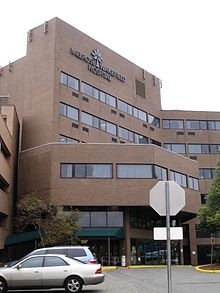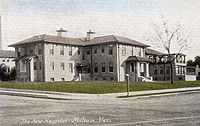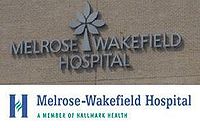- Melrose-Wakefield Hospital
-
Melrose-Wakefield Hospital Hallmark Health System 
Melrose-Wakefield Hospital Main Entrance Geography Location 585 Lebanon Street, Melrose, Massachusetts, United States Coordinates 42°27′37″N 71°3′41″W / 42.46028°N 71.06139°WCoordinates: 42°27′37″N 71°3′41″W / 42.46028°N 71.06139°W Organization Care system Private Hospital type General Services Emergency department Level II trauma center Beds 234 History Founded July 28, 1893 Links Website http://www.hallmarkhealth.org/melrose.html Lists Hospitals in Massachusetts Melrose-Wakefield Hospital (often abbreviated to "Melrose-Wakefield" or "Mel-Wak") is a 234-bed non-profit hospital located in Melrose, Massachusetts.[1] It is one of two general hospitals operated by Melrose based Hallmark Health System.
Melrose-Wakefield Hospital was home to the world's first cochlear implant and laser surgery and it was among the first hospitals in the country to offer same day surgery.[1][2] It is also among the top 10% of hospitals in the nation for stroke care and the top 15% in the nation for heart attack treatment.[2]
The hospital's door-to-balloon time is 92.67 minutes, compared with a national average of 155 minutes. Melrose-Wakefield Hospital also exceeds state averages for successful and timely patient outcomes.[3]
Contents
History
1893–1900: Beginnings
On July 28, 1893, the Melrose Hospital Association was established with forty-eight corporate members at the home of Decius Beebe on West Foster Street in Melrose, Massachusetts. The bylaws of the Association stated that the purpose for which the Association is constituted is to establish and maintain a hospital for the treatment and care of needy, sick and disabled persons of both sexes, and also of persons who may be able to pay for such treatment in whole or in part; such receipts to be used in the partial support of the hospital.[4]
At first, the hospital was not fully self sufficient, with the city often appropriating a sum of money towards its yearly expenses. During its beginnings, every third Sunday in May, local area churches collected contributions to support the hospital. In addition, the Hospital Guild, formed during the hospital's first year, held several fairs as fundraisers.[4]
The first hospital was in a former residence located at 39 Oakland Street, but it soon became too small for the association's needs so it purchased and moved to a home at 75 Myrtle Street. In 1894, the association purchased a plot of land on the corner of Lebanon and Porter Streets at 585 Lebanon Street where it moved to in 1913, and remains today.[4][5] Also in 1894, the Melrose Hospital School of Nursing opened in order to assure a continuous source of qualified labor.[5]
1950–1979: Expansion
In 1950, the trustees, administrators, and employees publicly rededicated themselves to the mission of providing a "modern, standardized and well-equipped" community hospital.[5] A separate emergency room was created with a full time nurse in charge and nursing assistants were integrated into hospital operations. A new surgical wing was built and the Colby Pavilion wing was completely remodeled. To deal with the Post-World War II baby boom, more maternity beds were added and the Children's Ward expanded bringing bed capacity to 187.[5]
In 1958, the hospital officially changed its name to "Melrose-Wakefield Hospital" to reflect the increasing utilization of its services by neighboring Wakefield, Massachusetts.
In 1965, the hospital named Jane Bain, a graduate of the School of Nursing, as director of the school. Under her direction, improvements were made in the School of Nursing's curriculum and facilities and a building at 340 Main Street was purchased for classrooms and a dormitory. The curriculum was expanded to include para-medical training for patient care and surgical technicians and led to the founding of the Physical Therapy Department, Electro-Encephalography Unit and an array of ambulatory psychiatric services.[5]
In 1967, Melrose-Wakefield opened its intensive care unit (ICU). The four-bed unit was one of the nation's first ICUs at a community hospital.[5]
During the late-1960s and early-1970s, a shift to outpatient treatment began in hospitals throughout the nation. In response, Melrose-Wakefield introduced a number of outpatient programs, including a breast cancer detection clinic, a cardiopulmonary testing laboratory, an occupational therapy unit, and a host of services provided by home health nurses. As part of its outpatient services, the hospital became one of the first hospitals in the nation to offer same day surgery.[6] In 1973, the hospital became the first in Massachusetts to offer a state-supervised course for the training of emergency medical technicians (EMTs)
In the mid-1970s, Dr. Geza Jako, a surgeon, medical researcher, and professor at Boston University Medical School demonstrated the first successful use of the laser as a surgical tool at Melrose-Wakefield Hospital.[1][5]
In 1975, Melrose-Wakefield launched a major campaign to expand the hospital. The $11 million renovation and replacement project added a six-story medical wing containing 100 new beds and a new home for the Radiology, Emergency, and Intensive Care units. Following the expansion, Melrose-Wakefield's School of Nursing graduated its last class of nurses and closed on May 30, 1976 due to financial concerns and changing trends in nursing education.[5]
1980–2005: Evolving and partnerships
As the prices for health care increased in the 1980s, the hospital was forced to once again adopt a modernization program to keep up with the times. Over the next decade, the plan called for the construction of a Surgical and Ancillary Services Building on the Rowe Street side of the building and the addition of a parking garage on Lebanon Street. Later renovations included the construction a nursery and new labor and delivery suites in the Maternity Ward and the addition of the Cummings Rehabilitation Center and a cardiac catheterization laboratory.[5]
Melrose-Wakefield also began working with its partners in the Community Hospitals of Eastern Middlesex (CHEM) organization to upgrade its shared medical facility on Montvale Avenue in Stoneham, Massachusetts. At the location, it offered radiation therapy for cancer patients and magnetic resonance imaging.[5]
On August 1, 1996, Melrose-Wakefield joined Whidden Memorial Hospital to form UniCare Health Systems as a way to reduce overhead, streamline operations, and effectuate improvements and expansions in services where necessary. A year later, in October 1997, UniCare merged with Lawrence Memorial Hospital of Medford and Malden Hospital, to form Hallmark Health.[7][8] Soon, the new company was in debt and forced to sell off Whidden Memorial Hospital to Cambridge Health Alliance. In later years, it renamed Malden Hospital as Malden Medical Center and cut services there making Melrose-Wakefield and Lawrence Memorial the only full service hospitals of Hallmark Health.
2006–present: The hospital today
In early September 2006, Melrose-Wakefield Hospital began offering elective angioplasty after being selected by the Massachusetts Department of Public Health (DPH) to participate in an elective angioplasty trial. The hospital was one of only seven throughout the state to participate in the "MASS COMM Trial" that studied the benefits of elective (non-emergency) angioplasty without on-site cardiac surgery back-up. The procedure, which is commonly performed in larger teaching hospitals in Boston offers patients the same care without requiring them to travel to a far distance.[3] The Cardiac and Endovascular Center officially opened in December 2007.[9]
On November 1, 2007, Melrose-Wakefield closed its Cummings Rehabilitation and Nursing Center. It had opened in December 1993 to treat patients needing hip and knee rehabilitation, as well as recovering surgery patients from New England Baptist, Beth Israel Deaconess and Mass General who had surgery and choose to recover closer to home. The 17-bed unit was replaced by a medical-surgical floor because of the hospital's need for more beds in that department. All patients were either sent to other nursing homes or home where they would be served by Hallmark Health's Visiting Nurse Association.[10] Today the Cummings Bone and Joint Center, renovated in September 2009, has replaced the medical-surgical unit and is one of the state of the art bone and joint programs in Boston's metro-north.
References
- ^ a b c "Melrose-Wakefield Hospital". Hallmark Health. http://www.hallmarkhealth.org/melrose.php. Retrieved 2008-07-19.[dead link]
- ^ a b "Healthcare Services & Elder Care". City of Melrose. http://www.cityofmelrose.org/Why%20Melrose/healthcare_services.htm. Retrieved 2008-07-19.[dead link]
- ^ a b "Walking for the cure". GateHouse Media. 2006-09-20. http://www.wickedlocal.com/melrose/archive/x902736867. Retrieved 2008-07-20.
- ^ a b c Goss, Elbridge Henry (1902). The History of Melrose. Melrose, MA: A. W. Dunton & Co.. pp. 341–344. http://books.google.com/books?id=MA98PsSsa9oC&pg=RA5-PA341&lpg=RA5-PA341&dq=%22history+of+melrose+hospital%22%22&source=web&ots=0QKeKtbDhw&sig=kQIlzWKFYhqL7mERnOaasO5RjLQ&hl=en&sa=X&oi=book_result&resnum=10&ct=result#PPP8,M1.
- ^ a b c d e f g h i j Centennial Publications Committee (March 1999). Melrose: Past, Present & Future. Melrose, MA: City of Melrose. pp. 158–165.
- ^ Gallase, Liz Roman (1974-01-04). "When Some People Tell About Operation, The Story Is Short". Wall Street Journal. http://pqasb.pqarchiver.com/wsj/access/72664939.html?dids=72664939:72664939&FMT=ABS&FMTS=ABS:AI&date=Jan+4%2C+1974&author=&pub=Wall+Street+Journal++(1889-Current+file)&edition=&startpage=1&type=historic&desc=When+Some+People+Tell+About+Operation%2C+The+Story+Is+Short. Retrieved 2008-07-21.
- ^ "Lechmere Site Eyed by TJ Maxx". The Boston Globe. 1997-12-28. http://nl.newsbank.com/nl-search/we/Archives?p_product=BG&p_theme=bg&p_action=search&p_maxdocs=200&p_topdoc=1&p_text_direct-0=0EADDCE95B55BFEC&p_field_direct-0=document_id&p_perpage=10&p_sort=YMD_date:D&s_trackval=GooglePM. Retrieved 2008-07-19.
- ^ "Inpatient Hospital Discharge Database Documentation Manual". State of Massachusetts. May 2006. http://www.mass.gov/Eeohhs2/docs/dhcfp/r/hdd/hdd_fy05.doc. Retrieved 2008-07-19.
- ^ "Year in Review - 2007". GateHouse Media. 2008-01-03. http://www.wickedlocal.com/melrose/town_info/history/x1295926275. Retrieved 2008-07-20.
- ^ "Melrose-Wakefield to close rehab unit". GateHouse Media. 2007-09-20. http://www.wickedlocal.com/melrose/archive/x1429052617. Retrieved 2008-07-20.
Categories:- Buildings and structures in Melrose, Massachusetts
- Hospitals in Middlesex County, Massachusetts
- Hospitals established in 1893
Wikimedia Foundation. 2010.


